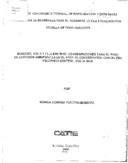| dc.contributor.advisor | Campos, José Joaquín | |
| dc.contributor.author | Turcios Mendoza, M.X. | |
| dc.date.accessioned | 2014-10-17T15:36:12Z | |
| dc.date.available | 2014-10-17T15:36:12Z | |
| dc.date.issued | 1999 | es_ES |
| dc.identifier | 361582 | es_ES |
| dc.identifier.uri | https://repositorio.catie.ac.cr/handle/11554/2177 | |
| dc.description | Tesis (M. Sc) -- CATIE, Turrialba (Costa Rica) 1999 | es_ES |
| dc.description | Referencias de las páginas 47-51 | |
| dc.description | Tablas | |
| dc.description.abstract | Este estudio tuvo como fin proveer información a las entidades responsables del pago por servicios ambientales, de tal forma que sirva como sustento y justificación para mejorar dicho mecanismo en el área de estudio y que pueda extenderse a otras que cuenten con las características de poseer un bosque que, a su vez, brinda su servicio a la humanidad. Para esto se escogió la cuenca del Río San Fernando por considerarse de importancia para FUNDECOR y para el Proyecto Hidroeléctrico de Energía Global, que tiene situado ahí el proyecto Don Pedro. Además, alrededor de esta cuenca se encuentran fincas incorporadas en el programa de Pago por Servicios Ambientales (PSA). Se recopiló información hidrológica, de un período de veinte años, de las estaciones meteorológicas alrededor de la cuenca en estudio, la cual, por ser una cuenca recientemente utilizada para fines hidrológicos, cuenta con poca información. Se recomienda realizar mediciones por tiempos mayores a un año para obtener datos más precisos generados por el modelo de Precipitación-Escorrentía. | es_ES |
| dc.description.abstract | This objective of the study was to provide information to the responsible for the payment for environmental services, in a manner that serves to sustain and justify the improvement of this mechanism in the study area, and which could be extended to other areas that have the characteristics to support a forest that, in turn, offers its service to humanity. To realize this goal, the watershed of the San Fernando River was chosen for its importance to FUNDECOR and to the Hydroelectric Global Energy Project in which is located the Don Pedro project. Also, around this watershed, are properties incorporated in the Payment for Environmental Services (PSA) program. Hydrological information was gathered, for a twenty year period, from the meteorological stations around the watershed under study, which, being a watershed recently used for hydrology, has little information. Interpolations with geographical information system prograMON such as ArcView and Idrisi, were utilized to obtain precipitation in the watershed, which was needed to determine the water balance of the watershed. To be able to support the PES System, the cost/benefit ratio of the Don Pedro Hydroelectric Project was determined if it decreased the runoff in the watershed due to deforestation. The interpolated value of the annual precipitation in the watershed was 4312 mm. | |
| dc.format.extent | 65 páginas | |
| dc.language.iso | es | es_ES |
| dc.publisher | CATIE, Turrialba (Costa Rica) | es_ES |
| dc.subject | CARBON DIOXIDE | |
| dc.subject | ENVIRONMENT | |
| dc.subject | FOREST RESOURCES | |
| dc.subject | NATURE CONSERVATION | |
| dc.subject | WATERSHEDS | |
| dc.subject | PRECIPITATION | |
| dc.subject | RUNOFFCOSTA RICA | |
| dc.subject | DIOXIDO DE CARBONO | |
| dc.subject | MEDIO AMBIENTE | |
| dc.subject | RECURSOS FORESTALES | |
| dc.subject | CONSERVACION DE LA NATURALEZA | |
| dc.subject | CUENCAS HIDROGRAFICAS | |
| dc.subject | PRECIPITACION ATMOSFERICA | |
| dc.subject | ESCORRENTIA | |
| dc.title | Bosques, agua y electricidad: consideraciones para el pago de servicios ambientales en el área de conservación Cordillera Volcánica Central, Costa Rica | es_ES |
| dc.title.alternative | Forests, water and electricity: considerations for the payment of environmental services in the Central Volcanic Mountain Range Conservation Area, Costa Rica | es_ES |
| dc.type | Tesis de maestría | es_ES |
| dc.identifier.publication | Turrialba (Costa Rica) | es_ES |


